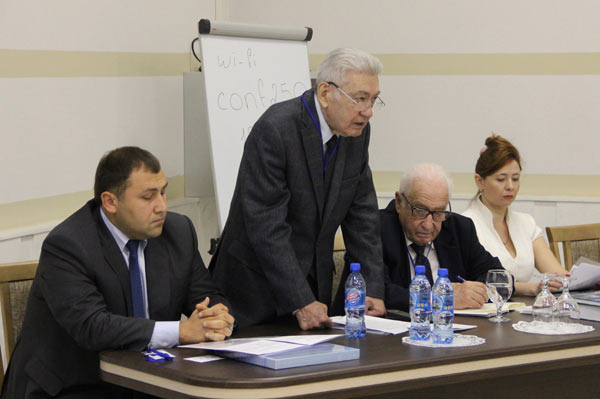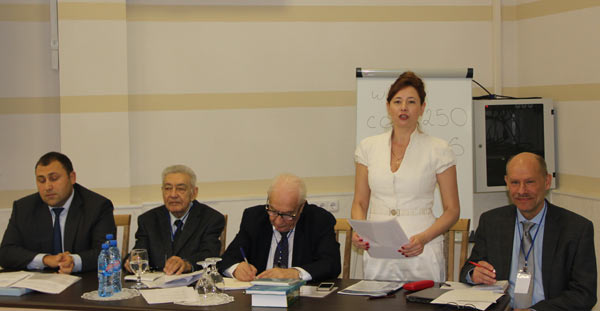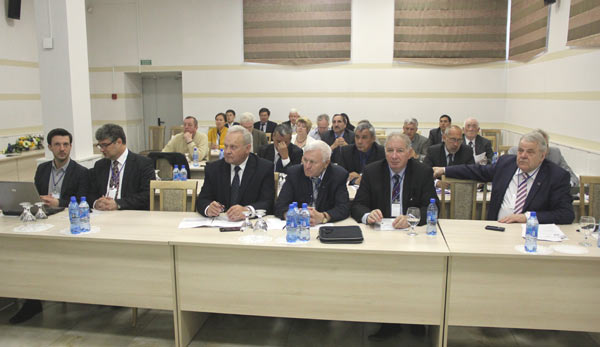INTERNATIONAL CONFERENCE OF NWO EECCA “WATER CONSERVATION AND EFFECTIVENESS OF WATER USE”
The Conference was held in Minsk, Belarus on the 21st of May 2015.
The key topics of the Conference discussion were:
- Report on NWO EECCA activity in 2014
- Growing water scarcity presenting challenges for water security: natural ones – climate change; and, anthropogenic ones – rising demands, future development, including of hydropower
- Issues related to application of high-tech in water uses (automation, water conservation, energy conservation, etc.)
- Water accounting and quality of water delivery services
The Conference was organized by OAO “Vodstroy”, Scientific-Information Center of ICWC, and Belarusian Research Institute for Land Reclamation.
President of NWO EECCA Academician P.A.Polad-Zade opened the Conference.

Welcome speeches were delivered by:
- B. Libert, Regional Advisor for Environment, UNECE
- S.B.Dunayevskaya, Director, Institute “Belgiprovodkhoz”
- E.Boinet, representative of the International Network of Basin Organizations
- M.K.Kerimov, Head of the Federal Water Resources Agency, Ministry of Natural Resources and Ecology, Russian Federation.

Then, the reports were delivered by:
Prof. V.A.Dukhovny - NWO EECCA activity in 2013-2014 and future tasks
B.Libert - Water-food-energy nexus approach for better water use
N.A. Sukhoy – Specifics of Land Reclamation Program implementation in the Russian Federation
V.I.Sokolov - Water conservation and efficient water use – the base for future survival
Prof. N.B. Prokhorova - Water conservation as a factor of socio-economic development
Acad. B.M.Kizyaev - Water resources and their role for development of the Russia’s agro-industry under climate change
A.D.Ryabtsev - Growing water scarcity as a water security challenge and the steps towards water cooperation
A.Sh.Mamedov - Rational methods of water and energy use in highlands
E.Boinet - The action program of the International Network of Basin Organizations and the assessment of the current progress in the implementation of the Water Framework Directive
A.A.Bulinya – Irrigation and drainage in Belarus and development outlook
N.K.Vakhonin - Status of land reclamation system in Belarus and innovative ways of its development
A.K.Fazilov - On-going improvement measures in the water sector of Uzbekistan
Prof. V.A.Stashuk - Characteristics of water use in Ukraine given the agrarian sector reformation and climate change
N.N.Balgabaev - Regional program for irrigation reconstruction and irrigated land reclamation in Kazakhstan with application of resource-conservation technologies: Zhambyl province case-study
V.N.Korneyev - Water resources management in the Neman River Basin in light of adaptation to climate change
Prof. N.Nosirov - Water conservation technologies in irrigated agriculture in Tajikistan
Prof. Ye.M.Kalibekova - Current status of water resources and related challenges in Kazakhstan
L.Kiktenko - Potential of down-top approach for water conservation – CAREC experience in Central Asia
M.Yu.Kalinin - Results of the Beralus-Moldova Project "Promotion of public participation in international cooperation on integrated transboundary river basin management in western countries of EECCA"
K.A.Anzelm - Application of water-saving irrigation technologies in Kazakhstan: South-Kazakhstan province case-study
M.Ya.Makhramov - Water accounting and control along the Amudarya River
A.R.Uktamov - Experience of application of automated water accounting at BWO Syrdarya

The Network President Academician P.A.Polad-Zade in his opening speech highlighted that our time is characterized by strong pressure on the water sector exerted by climate change and the global tendencies and problems. Recently, China has been developing intensively its hydropower projects and has transferred river flow south to north in the area adjacent to the EECCA region. As an example of how transboundary problems are solved, one can site the signature of a document on cooperation between Palestine, Israel, and Jordan for river sharing in the Middle East, taking into account huge reserves of seawater desalination and construction of a canal Red Sea – Dead Sea.
Today, in 50 years since the Program for Land Reclamation in USSR, which resulted in expansion of the irrigated area from 9.5 Mha in 1965 to 21 Mha in 1985, the current status of land use and water management in the Russian Federation causes serious concerns. It seems that, at present, the value of water is largely underestimated in Russia. However, the experience and knowledge accumulated in the country in the previous periods of irrigation and drainage development urge to radical revision of the focus in our water-related practices to serve as the basis of food and energy security and as a driver of progress and development.
Problems in Russia’s water sector were addressed in a number of other reports as well. In particular, N.A.Sukhoy analyzed significant shortcomings in the Russian water sector, such as lack of flood control that resulted in catastrophic floods in the Amur River and poor use of reclaimed land. Russia purchases food for $35 billion, while irrigators and farmers in Kuban demonstrate huge capacities of the Russian irrigated agriculture. Kuban produces as much as 1 Mt of rice annually. Thus, similar development of irrigated agriculture in other areas of the country may reject a need for food import. Unlike Central Asia, Russia does not experience water scarcity. The current water management system is a structural sector for national economy. However, today it is developed as a central resource-supplying sector. The role of water resources in the change of production patterns and population in Russia urges that the system, large scale multidisciplinary study be undertaken without delay so that to avoid transformation of predicted water crisis into the real-time one.
Mrs. Prokhorova, Director of the RosNIIVH Institute underlined that market conditions do not ensure sustainability and opportunities for survival in the water sector. There are no Federal laws on water use; small hydro is poorly implemented, whereas water resources in Volga, Don, Kuban, and Ural are exhausted virtually. There is growing number of unaccounted water diversions. The current monitoring system, which collects data from 11 departments, should be transformed into a system of forecasting and accounting. Water security practically is not legally supported in Russia.
Prof. V.A. Dukhovny, Executive Secretary of NWO EECCA, in his report highlighted the following contemporary water challenges in EECCA countries:
- Water should be the basis of global security.
- There is growing water scarcity in arid zones and increasing water availability in humid zones.
- Uneven spatial distribution of water.
- Poor water controllability.
- Development of hydro-egoism and difficulties with hydro-solidarity.
- Transboundary problems.
- Anthropogenic-technological risks.
- Need for harmonization of water, soil, climate and nature.
In order to overcome these challenges he proposed to:
- Overcome business as usual in development.
- Widen involvement of basin organizations – they see the situation better and more realistically as the lower chain.
- Enhance information exchange and establish an open knowledge bank.
- Focus on training, transfer of knowledge and development of a clear future vision (strategy).
- Restore previous capacities of waterworks facilities and irrigated areas that degraded over 20 years.
V.I.Sokolov delivered the keynote speech on water conservation issues.
In the recent decade, humanity grew aware of the global problems related to intensive water use. Today, it is a known fact that freshwater can be renewed in the global water cycle but their usable share is limited, i.e. with population growth and economic development, humanity has faced growing shortage of freshwater resources. This global phenomenon is aggravated by climate change. Increased scarcity of water for all needs of the society and the nature is observed all over the world, while this process is especially intensive in some regions.
Water demands exceed (especially during dry periods) an amount of technically available water resources in the rivers in Central Asia as a whole. With growing population and socio-economic needs, this creates problems in ensuring water security and, particularly, its food and environmental elements.
Irrigated agriculture in the Central Asian countries undergoes changes related with restructuring of agriculture and water sector.
- The number of individual water users increased enormously;
- Former on-farm irrigation network automatically transformed into inter-farm one (at WUA level);
- Today there are no effective tools for harmonization of different water supply levels in terms of the reduction of water losses at the interface of hierarchical levels (because of lack of coordination of water demand and water supply and weak information mechanism for coordination);
- Poor monitoring of water supply and water disposal that led to low reliability of water accounting. This also causes weak efficiency of water pricing;
- Cropping patterns have changed (especially winter wheat areas were increased significantly), with resulted consequences for irrigation regime;
- The changes in irrigation regime affected operation of irrigation systems (water is delivered continuously all year round).
The water conservation measures can be divided into two categories:
- water conservation during delivery of water to users
- water conservation during use of water.
A wide circle of issues need to be addressed at the level of water use:
- Need for appropriate system of planning of water distribution and use at the WUA-farmer level;
- Updating of water-duty (hydromodule) zoning and crop water requirement rates;
- Optimization of soil-reclamation regimes against current conditions of drainage and irrigation technique;
- Development of agronomic practices that improve soil fertility;
- Adoption of perfect irrigation methods;
- More financial incentives for water users in water saving – transfer from hectare-based water charges to charges determined on the basis of amounts of delivered water.
Here, it is necessary to remember that water conservation is not only a technological process but also an institutional one, which is closely linked with implementation of IWRM.
The Deputy Head of Central Water Administration of Uzbekistan A.Fazilov noted that Uzbekistan is leading in implementation of IWRM. IWRM was adopted in more than 130,000 ha in Fergana province and in additional 450,000 ha in the Zarafshan basin and other provinces in the Republic.
Other directions for improvement of irrigation and drainage system in Uzbekistan are:
- Adoption of up-to-date water conservation technologies
- Implementation of automated water distribution control and monitoring systems
- Improvement of conditions of hydraulic facilities
- Improvement of irrigated land conditions
- Agricultural diversification, etc.
Over the last decade 1,500 km of canals, 400 large hydraulic structures, and 200 pumping stations were constructed or reconstructed in the republic. Every year 5,000 km of main canals, 100,000 km of irrigation canals and ditches, and 10,000 hydraulic structures and gauging stations are cleaned. The total area under drip irrigation is more than 12,000 ha. Flexible hose irrigation and film irrigation are applied in 14,000 ha of irrigated land.
During 2013-2017 land users and farms will receive long-term loans on easy terms, at government’s expense, for:
- implementation of drip irrigation system on 25,000 ha
- flexible hose irrigation on 34,000 ha
- film irrigation on 45,600 ha.
These farms are free from land and other taxes for 5 years.
In opinion of Kazakh experts (A.D.Ryabtsev, D.Balgabaev, Prof. Kallibekova), Kazakhstan is the least provided with water per capita. The average long-term runoff of all rivers in Kazakhstan was estimated at 100.5 km3 in the recent past, whereas now it is estimated at only 85 km3 by some experts.
Aggravation of water availability issues in Kazakhstan is explained by the following reasons:
- more than 45 % of surface runoff is formed outside the republic and its diversion by riparian countries (China, Uzbekistan, Kyrgyzstan, Russia) increases;
- effect of global and regional climate change on river runoff;
- irregular distribution of water throughout the republic;
- high degree of water pollution.
In order to achieve water security in Kazakhstan and solve geopolitical, interstate, socio-economic tasks and in context of growing water scarcity, the country plans to re-distribute river runoff, particularly, transfer flow from the Yertis River via the Astana canal so that it would become the second independent source of water for the capital city.
A.D.Ryabtsev highlighted an importance of the state water management program, which set main tasks for guaranteed water supply to population, environment, and economic sectors through water conservation, more efficient water management and preservation of aquatic ecosystems. This program will require significant investments up to $18 billion for 2015-2020; however, re-distribution of flows in water-scarce basins within the boundaries of Kazakhstan would help to avoid water scarcity, which is predicted to be 8.5 billion m3. The world practices in modern flow re-distribution demonstrate feasibility of such measures. Moreover, neighbors of Kazakhstan, first of all, China already implement such water transfers even along the Irtysh River, particularly through the Irtysh-Karamai and Irtysh-Urumchi canals.
Agriculture is the largest consumer in the republic. It uses 94% of the total water diversion, including 80% for regular irrigation, in the three southern basins.
Irrigated agriculture in three Kazakh provinces should be developed further only through water conservation technologies, primarily drip irrigation. By present, as K.A.Anzelm noted, the drip irrigation area has been extended to 34,000 ha. This is the set of economic, financial, legal, and institutional measures with extended soft financing that allows successful implementation of water-conservation technologies. In doing so, 80 % of water delivery services through modern technique is compensated by the public sector.
Republic of Tajikistan has diverse natural-economic zones starting from rainfed land to sub-arid zones, where 98% of irrigated land is under furrow irrigation. Taking into account soil-topography conditions in the republic, the following irrigation methods and technologies are proposed:
- improve quality of furrow irrigation for row crops, orchards and vineyards by cutting micro-furrows;
- portable and stationary tube network is recommended for distribution of water over irrigated fields under furrow irrigation;
- drip irrigation is recommended for high-profitable crops (cotton, citrus plants, fruits and vines) under acute shortage of irrigation water. In this context, Republican scientists suggested various options of low-pressure drip systems for both row crops and perennial plants. The cost of construction and operation of such systems is 1.5-2 times lower than of traditional ones;
- irrigate fodder crops by impulse sprinkling;
- subsoil irrigation of vines;
- terraced irrigation of citrus plants.
Adoption of new advance irrigation technique and technologies helps to achieve high crop yields: 40-60 centner/ha of cotton; 50-60 centner/ha of cereals; up to 200-250 centner/ha of grapes; 1000 centner/ha of vegetables; 800-1,000 centner/ha of alfalfa. In doing so, productivity of labor increases 3-4 times, while irrigation water saving is 1.5-3 times higher.
Representatives of Belarusian water sector, A.A.Bulinya, N.K.Vakhonin, and V.N.Korneyev underlined the role of water management and land reclamation in their country. Belarus produces almost 1000 kg of grain and 600 kg of potato per capita. Local factories manufacture all equipment for maintenance of national water infrastructure. In 2001, 4,000 tons of fish were produced in the republic, whereas now, through fish farm development, the total fish production amounts to 17,000 tons. The republic implements integrated projects for both national and transboundary water, particularly the Neman River Project, which covers Belarus, Lithuania and partially Russia.
Representative of Azerbaijan A.Sh.Mamedov stressed that given the growing water scarcity, development of off-stream reservoirs that have not a negative effect on richer channels and do not cause competitiveness between hydropower and other water users is of importance.
The Conference adopted the resolution.
|